
HTML结构如下:
<table id="miyazaki">
<caption>The Films of Miyazaki</caption>
<thead>
<tr><th>Film<th>Year<th>Honor
<tbody>
<tr>
<td data-th="Film">My Neighbor Totoro
<td data-th="Year">1988
<td data-th="Honor">Blue Ribbon Award (Special)
<tr>
<td data-th="Film">Princess Mononoke
<td data-th="Year">1997
<td data-th="Honor">Nebula Award (Best Script)
<tr>
<td data-th="Film">Spirited Away
<td data-th="Year">2001
<td data-th="Honor">Academy Award (Best Animated Feature)
<tr>
<td data-th="Film">Howl’s Moving Castle
<td data-th="Year">2004
<td data-th="Honor">Hollywood Film Festival (Animation OTY)
</table>
注意代码中的data属性,每一个单元格的data属性都与表格的header相对应。
CSS样式
表格基本的CSS样式如下:
table#miyazaki caption {
font-size: 2remcolor: #444
margin: 1rem
background-image: url(miyazaki.png), url(miyazaki2.png)
background-size: contain
background-repeat: no-repeat
background-position: center left, center right
}
table#miyazaki {
border-collapse: collapse
font-family: Agenda-Lightfont-weight: 100
background: #333color: #fff
text-rendering: optimizeLegibility
border-radius: 5px
}
table#miyazaki thead th { font-weight: 600}
table#miyazaki thead th, table#miyazaki tbody td {
padding: .8remfont-size: 1.4rem
}
table#miyazaki tbody td {
padding: .8remfont-size: 1.4rem
color: #444background: #eee
}
table#miyazaki tbody tr:not(:last-child) {
border-top: 1px solid #ddd
border-bottom: 1px solid #ddd
}
下面是响应式表格的CSS代码:
@media screen and (max-width: 600px) {
table#miyazaki caption { background-image: none}
table#miyazaki thead { display: none}
table#miyazaki tbody td { display: blockpadding: .6rem}
table#miyazaki tbody tr td:first-child { background: #333color: #fff}
table#miyazaki tbody td:before {
content: attr(data-th)font-weight: bold
display: inline-blockwidth: 6rem
}
}
media query代码中隐藏表格的头部单元,并且将每一个单元格的data-th作为标签显示在单元格内容的前面。每一行的第一个单元格都设置了特别的背景色和前景色,使之更为清晰。
扩展
你现在可以缩放浏览器来看看效果,非常不错。但是上面的代码是不可扩展的:要添加一个新行必须手动为每个单元格添加一个data-th属性。要想做到自动化,可以在服务器端实现,如PHP。也可以通过javascript来实现它。
首先,将整个表格都进行简化:
<table id="miyazaki">
<caption>The Films of Hayao Miyazaki</caption>
<thead>
<tr><th>Film<th>Year<th>Honor
<tbody>
<tr>
<td>My Neighbor Totoro
<td>1988
<td>Blue Ribbon Award (Special)
<tr>
<td>Princess Mononoke
<td>1997
<td>Nebula Award (Best Script)
<tr>
<td>Spirited Away
<td>2001
<td>Academy Award (Best Animated Feature)
<tr>
<td>Howl’s Moving Castle
<td>2004
<td>Hollywood Film Festival (Animation OTY)
</table>
然后在文档的底部添加下面的javascript代码:
<script>
var headertext = []
var headers = document.querySelectorAll("#miyazaki th"),
tablerows = document.querySelectorAll("#miyazaki th"),
tablebody = document.querySelector("#miyazaki tbody")
for(var i = 0i <headers.lengthi++) {
var current = headers[i]
headertext.push( current.textContent.replace( /\r?\n|\r/,"") )
}
for (var i = 0, rowrow = tablebody.rows[i]i++) {
for (var j = 0, colcol = row.cells[j]j++) {
col.setAttribute("data-th", headertext[j])
} }
</script>
上面的代码的意思是:获取每一个<th>中的文本内容,然后分别剔除它们的回车和换行符。然后将这些文本分别添加到适当的单元格的data属性上,添加的规则与CSS样式的规则相一致。(使用setAttribute要比dataset要好,后者只有在IE 11中得到支持。)
响应式布局最简单的就是用css3来实现。我举一个最简单的例子。下面是html代码。
<!DOCTYPE html>
<html lang="en">
<head>
<meta charset="UTF-8">
<meta name ="viewport" content="width = device-width,initial-scale=1">
<title>index01</title>
<link href="style01.css" type="text/css" rel="stylesheet">
</head>
<body>
<div class="heading">第一</div>
<div class="container">
<div class="left">第二</div>
<div class="main">第三</div>
<div class="right">第四</div>
</div>
<div class="footing">第五</div>
</body>
</html>
下面是css3代码
*{
margin:0px
padding: 0px
}
.heading,
.container,
.footing{
margin: 10px auto
}
.heading{
height: 100px
background-color: red
}
.left,
.right,
.main{
height: 300px
background-color: yellow
}
.footing{
height: 100px
background-color: gray
}
<!--media="only screen and (max-width:640px)" 这句话的意思是:只要当渲染屏幕的宽度不大于640px的时候才会使用这个样式表-->
@media screen and (min-width: 960px){
.heading,
.container,
.footing{
width:960px
}
.left,
.main,
.right{
float: left
height: 500px
}
.left,
.right{
width:200px
}
.main{
margin: 0px 5px
width:550px
}
.container{
height: 500px
}
}
@media screen and (min-width: 600px) and (max-width: 960px){
.heading,
.container,
.footing{
width: 600px
}
.left,
.main{
float: left
height:400px
}
.right{
display: none
}
.left{
width: 160px
}
.main{
width: 435px
margin-left: 5px
}
.container{
height: 400px
}
}
@media screen and (max-width: 600px){
.heading,
.container,
.footing{
width: 400px
}
.left,
.right{
width: 400px
height: 100px
}
.main{
margin-top: 10px
width:400px
height:200px
}
.right{
margin-top: 10px
}
.container{
height: 420px
}
}
这样就可以实现简单的响应式布局!如果你想要了解的话,可以到华清远见学习一下。我就是在那里学习的。
1.调整视口代码实例:
<!DOCTYPE html><head>
<meta charset="UTF-8" />
<title>布局之路-移动端开发实例</title>
<meta name="viewport" content="width=device-width,user-scalable = no" />
<link rel="stylesheet" type="text/css" href="css/reset.css" />
</head>
<body>
<div class="wrap"></div>
</body>
</html>
代码解析:由于使用不同设备打开网页时,宽度均有所不同,所以不能讲视口设置为固定值,应当为width=device-width,即将视口设置为当前设备的宽度。
2.确定设计图的最小字体浏览器(部分)能够显示的最小字体未12px,当移动端页面宽度为320px时,要保证最小字体为12px,那么在1080px的设计图中,最小字体应当为42px。
代码实例:
<style type="text/css">html {
font-size: 42px
}
</style> 3.浮动布局
各个区块都是浮动的,不是固定不变的。为了能自适应各个窗口。
代码实例:
.main {float: left
width: 70%
}
.box {
float: left
width: 60.93%
font-size: 1.71rem
text-align: center
line-height: 4.64rem
}
float浮动的好处就是,如果宽度不够放置下这个元素,元素会自动滚动到下方。
4.通过媒介查询,为不同设备加载相应样式有条件应用样式:
<style>@media all and(min-width:500px){ ... }
@media (orientation){ ... }
</style>
代码解析:
第一行媒体查询代码指的是:为宽度大于等于500px的设备设置样式。
第二行媒体查询代码指的是:为纵屏状态(可见区域大于或等于宽度)下的移动端设备设置样式。
有条件的加载样式表:
<head><link rel="stylesheet" href="wide.css" media="screen and(min-width:1024)" />
<link rel="stylesheet" href="mobile.css" media="screen and(max-width:320)" />
</head>
代码解析:
第一行媒体查询代码指的是:为宽度大于等于1024px的设备,加载wide.css文件。
第二行媒体查询代码指的是:为宽度小于等于320px的设备,加载mobile.css文件。
5.使用百分比和rem替换px
除了布局和文本,"自适应网页设计"还必须实现图片的自动缩放。
代码效果对比:
/*使用固定像素*/.box {
float: left
width: 658px
font-size: 72px
text-align: center
line-height: 195px
}
/*使用百分比和rem*/
.box {
float: left
width: 60.93%
font-size: 1.71rem
text-align: center
line-height: 4.64rem
}
代码解析:
水平方向的值,将具体像素调整为百分比。百分比的计算是根据父级的内容区宽度进行计算的。
例如,父级宽度为1080px, 子级元素为197px,那么子元素转换为百分比为:197/1080*100%=18.24%。需要注意的是百分比根据父级计算,当标签结构级别不同时,计算公式中的“分母”也有所不同,在开发时这个地方很容易出现问题,请务必注意。
垂直方向的值,将具体像素调整为rem,与水平方向相比,垂直方向的计算就比较简单。例如,行高为195px,HTML标签当前的字体大小为42px,将行高转换为rem单位,即195/42= 4. 64rem。
欢迎分享,转载请注明来源:内存溢出

 微信扫一扫
微信扫一扫
 支付宝扫一扫
支付宝扫一扫
评论列表(0条)